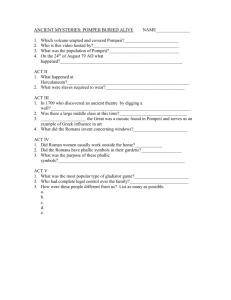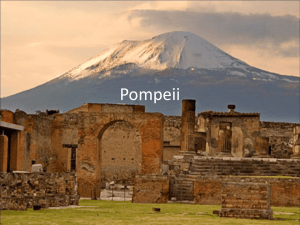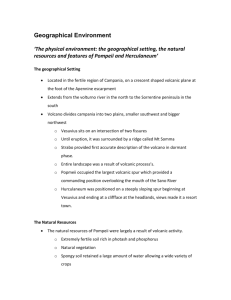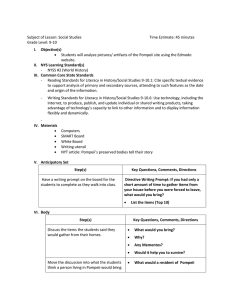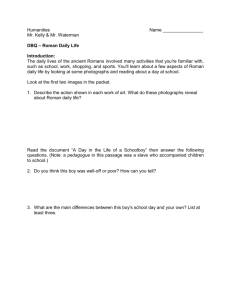Pompeii Report
advertisement
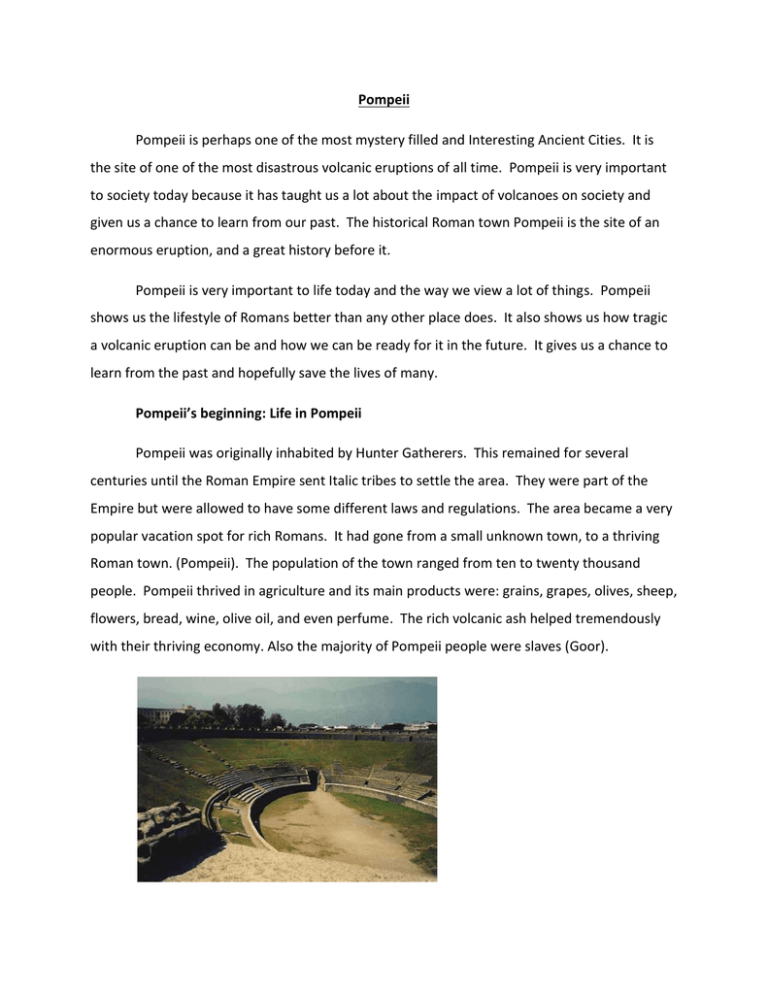
Pompeii Pompeii is perhaps one of the most mystery filled and Interesting Ancient Cities. It is the site of one of the most disastrous volcanic eruptions of all time. Pompeii is very important to society today because it has taught us a lot about the impact of volcanoes on society and given us a chance to learn from our past. The historical Roman town Pompeii is the site of an enormous eruption, and a great history before it. Pompeii is very important to life today and the way we view a lot of things. Pompeii shows us the lifestyle of Romans better than any other place does. It also shows us how tragic a volcanic eruption can be and how we can be ready for it in the future. It gives us a chance to learn from the past and hopefully save the lives of many. Pompeii’s beginning: Life in Pompeii Pompeii was originally inhabited by Hunter Gatherers. This remained for several centuries until the Roman Empire sent Italic tribes to settle the area. They were part of the Empire but were allowed to have some different laws and regulations. The area became a very popular vacation spot for rich Romans. It had gone from a small unknown town, to a thriving Roman town. (Pompeii). The population of the town ranged from ten to twenty thousand people. Pompeii thrived in agriculture and its main products were: grains, grapes, olives, sheep, flowers, bread, wine, olive oil, and even perfume. The rich volcanic ash helped tremendously with their thriving economy. Also the majority of Pompeii people were slaves (Goor). The Tragic Eruption The thing that makes Pompeii unique is the tragic volcanic eruption that happened there. Mount Vesuvius, a nearby volcanic mountain, had been inactive for 2,000 years (Rattini). The people of Pompeii were going about their lives normally. There had been an earthquake recently but the people did not make a big deal out of it. This was actually a sign for a major volcanic eruption. Mt. Vesuvius erupted in AD 79, on August 24th. It is thought to have happened when the people were eating lunch (Goor). Smoke went up to 20 miles high. Eleven hours after the explosion the volcanic ash went down the side of the mountain at an amazing speed of 180 mph., and it destroyed everything in its path (Rattini). If this did not kill the people than the gas that filled the air took care of them. Many people attempted to leave by boat in the harbor. This was not even possible, because the water was full of volcanic ash (Goor). Pompeii was buried in 23 ft. of ash and rock (Wilmere). In the first couple days of the explosion people tried to dig their way out of the ash (Goor). Pompeii: Life After the Eruption After the volcanic eruption, Pompeii became a “no man’s land.” People called the area Civitas, which means ancient city, and grass grew over the site. No one returned to Pompeii because there were still pockets of poisonous gas underneath the layers of lava. For more than 1500 years, Pompeii laid untouched, buried, and forgotten. In 1594 people came in contact with Pompeii for the first time since the eruption. Some workmen were digging a channel to bring water to a rich man’s villa and they actually found pieces of ruined building, which said, Decurias Pompeii. Regardless they did not make a big deal about it. The next contact by humans occurred in 1709. An Austrian Prince had a well dug on his property, and they ended up digging into the theatre of Herculaneum, which is right beside Pompeii. Later on in 1748, Roque de Alcubierre started creating an archeological plan to try and dig up Pompeii. Later on, a breakthrough occurred and Guiseppe Fiorelli came up with the theory that the hardened ash would form around the Pompeii bodies (Goor). Eventually all of Pompeii had been recovered and what was found was very remarkable. What is Pompeii like Today? Pompeii can be seen today exactly how it was in its last few moments. The layers of ash helped preserve the city. (Goor) The volcanic ash had preserved everything, even jewels, tools, games, furniture, food, plant roots, wooden floors, gates, and paintings (Goor). Also, when the dead bodies decayed the surrounding hardened ash created the forms of the bodies. Gladiator results can be seen on the amphitheatre walls (Rattini). Today, we can see the large wall that the Romans built around Pompeii and 20 foot high water towers that provided drinking water for the public. There were even water fountains all around the city like today. In addition, drains were found beneath the roads (Goor). Pompeii is open to the public to come and visit and is so unique because it shows us exactly how life had been for people in the Roman Empire. The Future of Pompeii and Mount Vesuvius Today there are 600,000 people living in ‘zona rosa’ which is the present day Pompeii. Also, 3 million people live in Naples which is close to Pompeii. This proves that an eruption today would be disastrous (Rattini). Vesuvius is due for another eruption any time which will follow the 2,000 period between major eruptions. The goal today and in the future is to monitor plate activity and gas pressure (Wilmere). This is vital because knowing when the eruption will occur could be the thing that will save millions of people from the fate that Pompeii suffered millennia ago. Works Cites Goor, Ron. Pompeii: Exploring a Roman Ghost Town. Cambridge, Mass: HarperCollinsPublisher, 1986. Poehler, Eric. “Rush Hour in Pompeii.” Archeology Nov/Dec 2008 Rattini, Kristin. “The Lost City of Pompeii.” National Geographic Kids Feb. 2009 Wilmere, Kathy. “Pompeii.” Junior Scholastics 1/24/2005 “Pompeii.” Pompeii 1978 10/28/10 http://www.mnsu.edu/emuseum/archeology/sites/europe /Pompeii.html Pictures: travelpod.com historylink102.com destination360.com/Europe/Italy/Pompeii archeology.org
